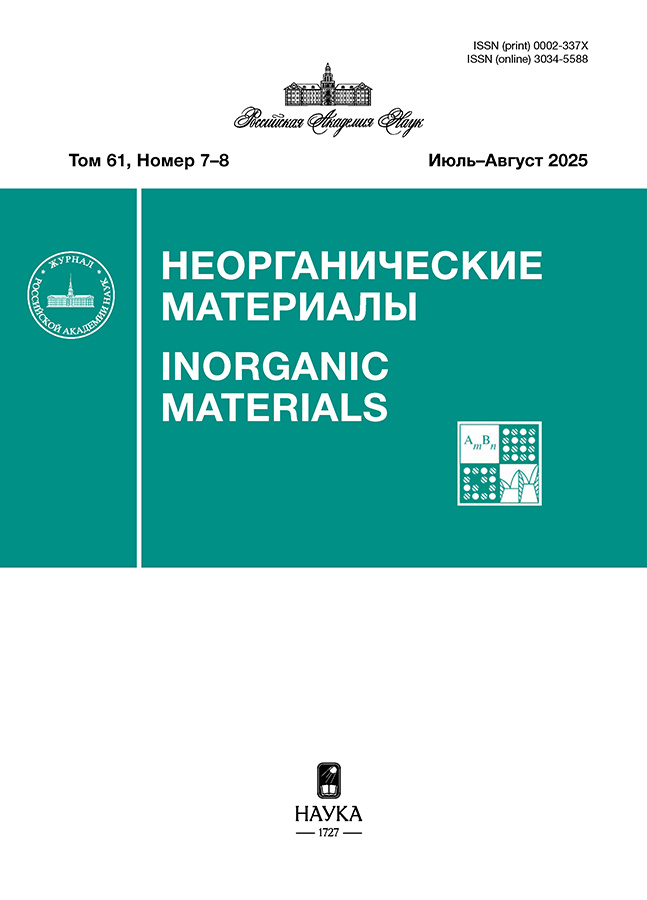Высокотемпературная теплоемкость и термодинамические свойства силикатов LiMSiO4 (M = Y, Yb, In) в области 320–1050 K
- Autores: Vasiliev G.V.1, Denisova L.T.1, Kargin Y.F.2, Belousova N.V.1, Denisov V.M.1, Irtugo L.A.1
-
Afiliações:
- Siberian Federal University
- A. A. Baikov Institute of Metallurgy and Materials Science of the Russian Academy of Sciences
- Edição: Volume 61, Nº 7-8 (2025)
- Páginas: 440-445
- Seção: Articles
- URL: https://clinpractice.ru/0002-337X/article/view/692250
- DOI: https://doi.org/10.7868/S3034558825040074
- ID: 692250
Citar
Texto integral
Resumo
Palavras-chave
Sobre autores
G. Vasiliev
Siberian Federal UniversityProspect Svobodny, 79, Krasnoyarsk, 660041 Russia
L. Denisova
Siberian Federal University
Email: ldenisova@sfu-kras.ru
Prospect Svobodny, 79, Krasnoyarsk, 660041 Russia
Y. Kargin
A. A. Baikov Institute of Metallurgy and Materials Science of the Russian Academy of SciencesLeninsky Prospect, 49, Moscow, 119991 Russia
N. Belousova
Siberian Federal UniversityProspect Svobodny, 79, Krasnoyarsk, 660041 Russia
V. Denisov
Siberian Federal UniversityProspect Svobodny, 79, Krasnoyarsk, 660041 Russia
L. Irtugo
Siberian Federal UniversityProspect Svobodny, 79, Krasnoyarsk, 660041 Russia
Bibliografia
- Nakayama S., Sakamota M. Microstructures and Electrical Properties for LiXSiO4 (X = Al, Y, La, Nd, Sm, Gd, Dy, Ho, Er, Yb) // J. Ceram. Soc. Jpn. 1992. V. 100(6). P. 867–871. https://doi.org/10.2109/jcersj.100.867
- Никольский Ю.В., Максимов Б.А., Белов Н.В. Кристаллическая структура LiYSiO4 // Докл. АН СССР. 1976. Т. 230. № 2. С. 331–333.
- Филипенко О.С., Димитрова О.В., Атовмян Л.О., Леонова Л.С. Кристаллическая структура нового редкоземельного ортосиликата Li и ионная проводимость LiYSiO4 // Кристаллография. 1989. Т. 34. № 4. С. 1009–1011.
- Fu Z.-W., Heng Y.-K., Qi M. et al. Scintillating properties of LiYSiO4: Ce // Chin. Phys. C. 2011. V. 35. № 12. P. 1134–1138. https://doi.org/10.1088/1674-1137/35/12/010
- Shi R., Liu G., Liang H. et al. Consequences of ET and MMCT on Luminescence of Ce3+-, Eu3+-, and Tb3+-Doped LiYSiO4 // Inorg. Chem. 2016. V. 55. P. 7777–7786. https://doi.org/10.1021/acs.inorgchem.6b01249
- Su C., Ao L., Zhang Z. et al. Crystal Structure, Raman Spectra and Microwave Dielectric Properties of Novel Temperature-Stable LiYbSiO4 Ceramics // Ceram. Int. 2020. V. 46. P. 19996–20003. https://doi.org/10.1016/j.ceramint.2020.05.070
- Redhammer G.J., Roth G. LiInSiO4: a New Monovalent – Trivalent Olivine // Acta Crystallogr., Sect. C. 2003. V. 59. P. 38–40. https://doi.org/10.1107/S0108270103006345
- Rajkumar T., Nakayama M., Nogami M. Ab initio Prediction for the Ionic Conduction of Lithium in LiInSiO4 and LiInGeO4 Olivine Materials // Solid State Commun. 2010. V. 150. P. 693–696. https://doi.org/10.1016/j.ssc.2010.01.044
- Ganesan M. A New Promising High Temperature Lithium Battery Solid Electrolyte // Electrochem. Commun. 2007. V. 9. P. 1980–1984. https://doi.org/10.1016/j.elecom.2007.05.012
- Sidorenko A.V., Dorenbos P., Bos A.J.J. et al. Lanthanide Level Location and Charge Carrier Trapping in LiLnSiO4: Ce3+, Sm3+, Ln = Y or Lu // J. Phys.: Condens. Matter. 2006. V. 18. P. 4503–4514. https://doi.org/10.1088/0953-8984/18/19/006
- Ganesan M. Synthesis and Characterization of Lithium Holmium Silicate Solid Electrolyte for High Temperature Lithium Batteries // J. Appl. Electrochem. 2009. V. 39. P. 947–951. https://doi.org/10.1007/s10800-008-9754-5
- Sunny A., Laser K.A., Manu K.M. et al. Effect of Glass Fluxing on Densification and Microwave Dielectric Properties of LiInSiO4 Ceramic // J. Alloys Compd. 2013. V. 552. P. 83–87. https://doi.org/10.1016/j.jallcom.2012.10.064
- Sun X., Tripathi R., Popov G. et al. Stabilization of Lithium Transition Metal Silicates in the Olivine Structure // Inorg. Chem. 2017. V. 56. P. 9931–9937. https://doi.org/10.1021/acs.inorgchem.7b01453
- Успенская И.А., Иванов А.С., Константинова Н.М., Куценок И.Б. Методы оценки теплоемкости кристаллических фаз // Журн. физ. химии. 2022. Т. 96. № 9. С. 1302–1310. https://doi.org/10.31857/S0044453722090291
- Демьяненко Л.Н., Лобачев А.Н., Емельченко Г.А.Германаты редкоземельных элементов. М.: Наука, 1980. 152 с.
- Денисова Л.Т., Иртюго Л.А., Каргин Ю.Ф., Белецкий В.В., Денисов В.М. Высокотемпературная теплоемкость и термодинамические свойства Tb2Sn2O7 // Неорган. материалы. 2017. Т. 53. № 1. С. 71–73. https://doi.org/10.7868/S0002337X17010043
- Maier C.G., Kelley K.K. Equation for the Representation of High Temperature Heat Content Data // J. Am. Chem. Soc. 1932. V. 54. № 8. P. 3234–3246. https://doi.org/10.1021/ja01347a029
- Leitner J., Chuchvalec P., Sedmidubský D. et al. Estimation of Heat Capacities of Solid Mixed Oxides // Thermochim. Acta. 2003. V. 395. P. 27–46. https://doi.org/10.1016/S0040-6031(02)00176-6
- Leitner J., Voňka P., Sedmidubský D., Svoboda P. Application of Neumann–Kopp Rule for Estimation of Heat Capacity of Mixed Oxides // Thermochim. Acta. 2010. V. 497. P. 7–13. https://doi.org/10.1016/j.tca.2009.08.002
- Резницкий Л.А. Калориметрия твердого тела (структурные, магнитные, электронные превращения). М.: Изд-во МГУ, 1981. 184 с.
- Tanifujl T., Shiozawa K., Nasu S. Heat Ccapacity of Lithium Oxide from 306 to 1073 K // J. Nucl. Mater. 1978. V. 78. P. 422–434.
- Sun Z., Li M., Zhou Y. Properties of Single-Phase Y2SiO5 // J. Eur. Ceram. Soc. 2009. V. 29. P. 551–557. https://doi.org/10.1016/j.jeurceramsoc.2008.07.026
- Zhang Y., Jung I.-H. Critical Evaluation of Thermodynamic Properties of Rare Earth Sesquioxides (RE = = La, Ce, Pr, Nd, Pm, Sm, Eu, Gd, Ho, Er, Tm, Yb, Lu, Sc and Y) // Calphad. 2017. V. 58. P. 169–203. https://doi.org/10.1016/j.calphad.2017.07.001
- Цагарейшвили Д.Ш., Гвелесиани Г.Г. Энтальпия и теплоемкость полуторной окиси индия при высоких температурах // Теплофизика высоких температур. 1975. Т. 13. № 4. С. 874–875.
- Осина Е.Л. Термодинамические функции молекул оксидов германия в газовой фазе: GeO2(г), Ge2O2(г) и Ge2O3(г) // Теплофизика высоких температур. 2017. Т. 55. № 2. С. 223–227. https://doi.org/10.7868/S0040364417020120
- Кумок В.Н. Проблема согласования методов оценки термодинамических характеристик // Прямые и обратные задачи химической термодинамики. Новосибирск: Наука, 1987. С. 108–123.
- Leiner J., Sedmidubský D., Chuchvalec P. Prediction of Heat Capacities of Solid Binary Oxides from Group Contribution Method // Ceramics-Silikáty. 2002. V. 46(1). P. 2932.
Arquivos suplementares










